Lorette C. Luzajic heats up the February edition of Wine and Art.
Like every holiday, Valentine’s Day is a dense mishmash of origins, a syncretic layer cake of pagan debauchery, sacred saintliness, curious cultural customs, and invented lore. And for all that Valentine’s Day is the least religious of all the holy days, it is the one met with the most contempt. If the historical Church was often successful in overlaying pagan festivals with something a little more pious, in this case plunking down a random saint who had nothing to do with love and romance never quashed the wanton eroticism of the day’s origin. Who wanted to remember some poor ancient martyr who cared for blind or epileptic children, when the real deal was all about getting naked?
On the other hand, the lonely have long sneered at those who have someone to take off their clothes for, griping about the reprehensible pressure such celebrations foisted on the single or unloved. Hence, Single Awareness Day was born in recent times, a refutation of romance and a declaration of independence.
Still others decry the crass commercializing of pure and sublime notions like love, shocked by the orgiastic excess of 18 billion dollars in world sales in chocolates and roses. But such outrageous consumption cannot hold a candle to the hedonism and extremism of the actual orgies of Lupercalia, history’s February fertility rites. Thankfully, we do not sacrifice and skin goats and dogs today, then violently beat young maidens with their warm and bloody pelts to ensure their fecundity before mating with them.
Loved, lonely, miserably attached, or blissfully liberated from attachment, the best approach to the February fever is to liberally imbibe some stellar wines. It turns any occasion into a celebration, whether in solitude or among friends or foes. And regardless whether you are flying solo or participating in goat-skinning or baby making festivities, indulge your sensual imagination by sneaking a peek at some incredible erotic art.
Leda and the Swan by Lelio Orsi

If you’re not squeamish about the birds and the bees, do yourself a favour and Google paintings of Leda and the Swan. There are literally hundreds of artworks depicting this spectacular story from classical mythology. Some of them are magnificent, like Lelio Orsi’s 16th century masterpiece. Perusing the gamut of artworks over the centuries through to the current day is a fascinating voyage through various facets and interpretations of the story. The gist of it was that the god Zeus wanted a married mortal named Leda, and he took the form of a swan to make love to her, ultimately impregnating her with twins, which later hatched as eggs.
The paintings frequently depict a disconcerting passion and intimacy between woman and bird, and other times the love scene is heavy with sorrow. Both types can be quite pornographic. Some of the most graphic depictions are also the most tender. Much depends on whether the artist interpreted the story of Zeus’s animal (avian) lust as seduction or as rape, as both versions are longstanding.
Your jaunt through centuries past might leave you wondering if the ancient artists were all perverts obsessed with bestiality. There’s a reason so many painters were eager to tackle the subject, however: naked ladies have always been popular, and it was more acceptable in days gone by to showcase women cavorting with mythic beasts and birds then it was to show them thus intertwined with actual men.
Ideally, someone would happen to have a bottle of Australia’s Leda Swan Chenin Blanc from the noughties gathering dust in their wine cellar, because a mouthful of fruity feathers with label illustration matching our story is the right pairing for this painting. I did not get so lucky, and if you don’t either, find a nice Sauvignon Blanc from Italy, something appropriately airy and sensual.
Rolla by Henri Gervex
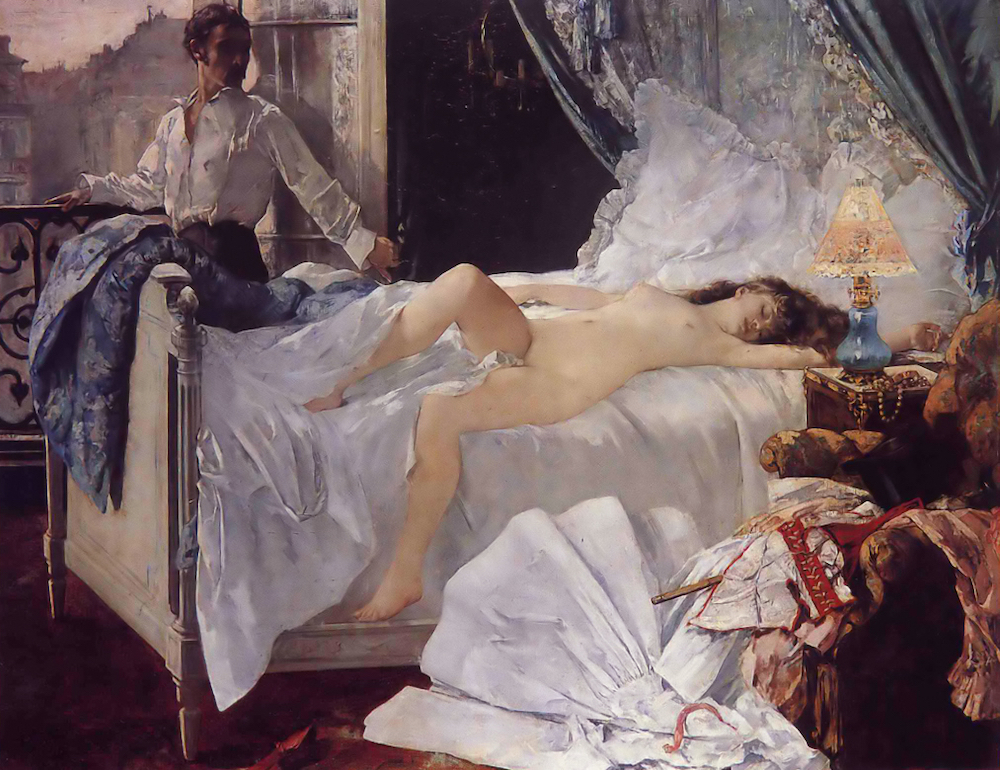
The prostitute and prostitution is one of the great themes of art and literature, recurring in poems, paintings, myths, sculptures, operas, Bible stories, and Pretty Woman. In every way, this history is herstory and ourstory. It is of course, a story of frequent condemnation and revulsion. But that’s hardly the whole truth and nothing but the truth. The prostitute is everything from fearless spy to the great sacred mother to the messenger of God. There is the sin and there is also the salvation. There is the temptation. There is the mystique, the freedom, the social realism, the unrequited love, the unknown paternity, the consort of kings, the heart of gold.
Here, in Gervex’s 1878 rejected Salon masterpiece, we have what Sotheby’s called the “most famous morning after scene in art history.” The painting contrasts the intense, tense character of Jacques Rolla – a subject from an early 19th century poem by Alfred de Musset – with the carefree luxuriating of the satiated female figure, Rolla’s favourite lady of the evening, Marie. In yet another case of a man having spent his fortune carelessly on wine, women, and song, the ruined Rolla, having decided on suicide, just spent his last night on earth with the most beautiful woman on earth.
Gervex the artist was himself enraptured by a courtesan creature, the lovely Valtesse de Bigne. And Rolla’s lady love, along with other women of Gervex’s brush, look an awful lot like she did.
What sort of wine to drink with honey-haired hookers? I was smitten after three sips of Tenuta del Buonamico Montecarlo, a six grape Italian blend, and a bargain for $20 at full blossom.
Male Organ, circa 6000 BC, Anatolia, Turkey
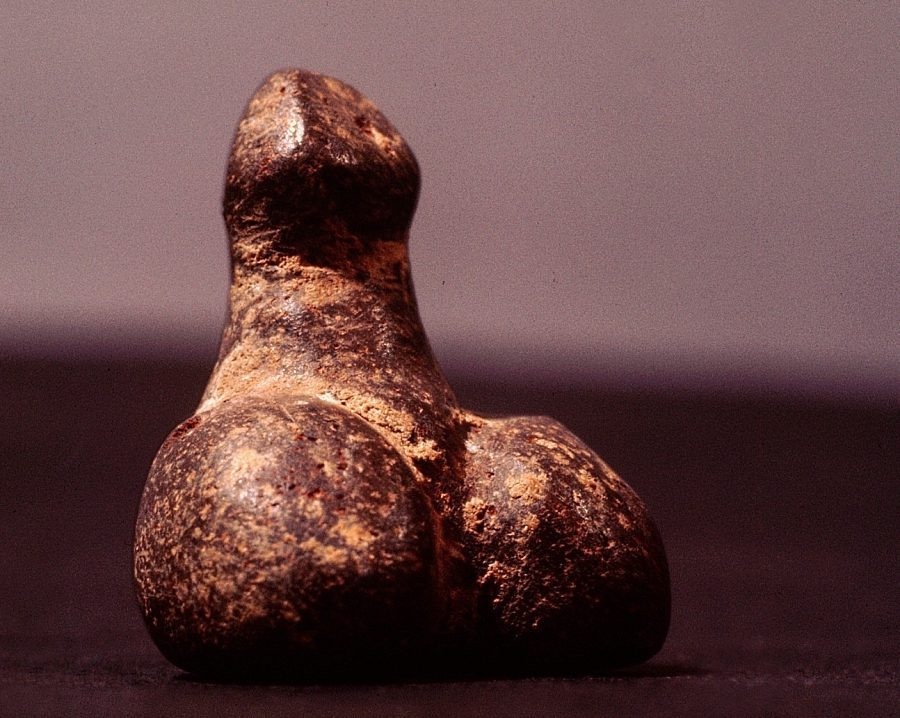
The phallus in art history and ritual is common over most cultures, often depicted as grossly exaggerated in size. In other times, miniatures were carried as talismans to ward off evil and conjure life, such as with this Penis of Willendorf amulet from the ancient Anatolians.
Now, what does one down with a good luck pocket rocket? Something zany and earthy that will help us fend off the bad vibes and keep us ripe and ready. You won’t find much in way of Turkish wines. But Georgia’s not far, with a renaissance underway of the world’s oldest wines. The LCBO has a few worth an evening – the Mukuzani Dry is the kind of thick and chewy red with character that I love most. And it’s almost as ancient as this artwork.
Biblis and Caunus, by Laurent Delvaux
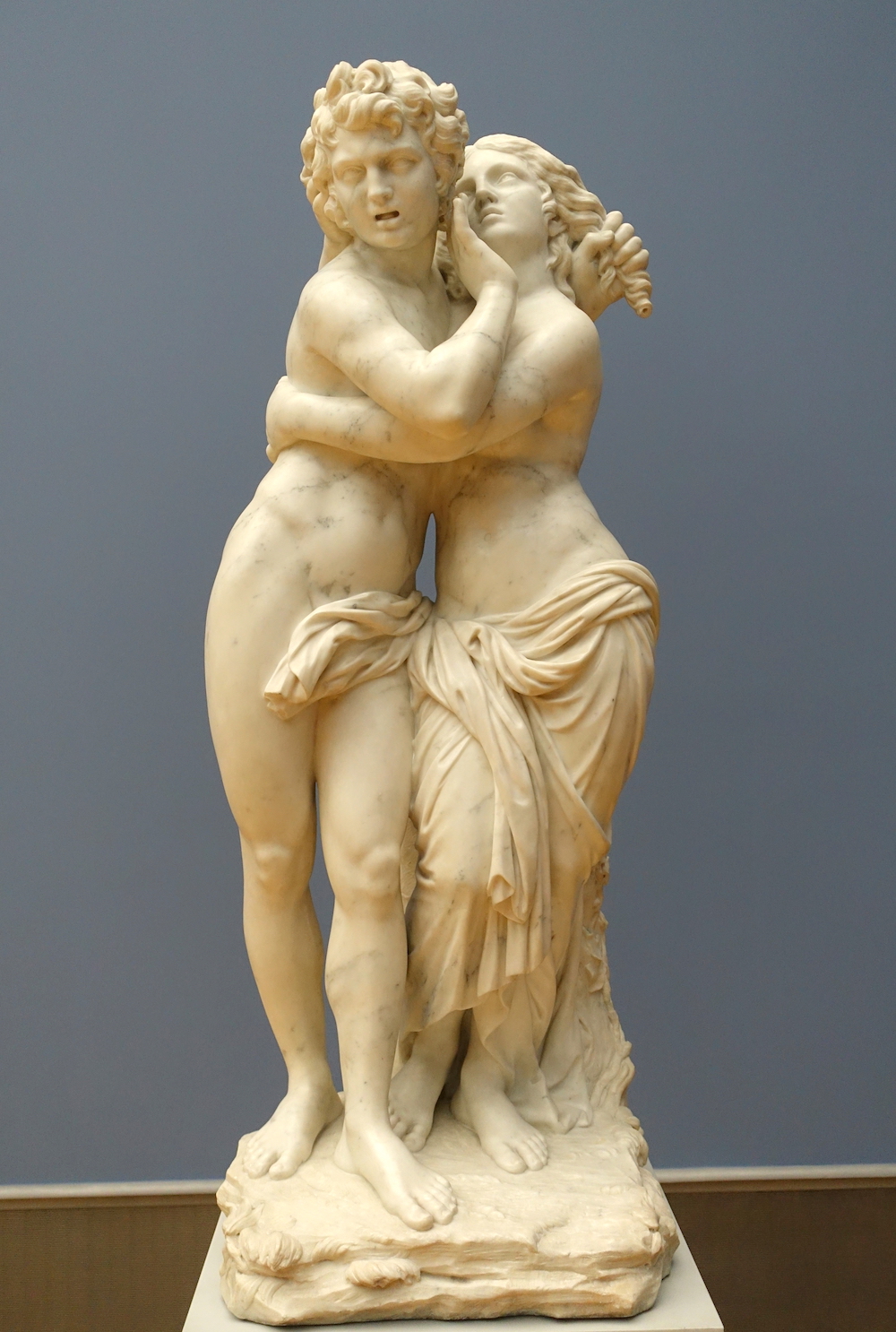
This spectacular marble sculpture appears at first glance to celebrate the beautiful bodies of youthful lovers, but if you’re picking up something of an ick factor, you’re sensing that the young man with the taut abdomen and tousled head of curls is not pulling at her hair or cupping her face in the throes of passion. Caunus is trying to get away from the undertow of desire, for he does not want what he wants- to yield to the insistent arduous advances of his twin sister.
The stories of classical mythology are simultaneously eternal/noble and Jerry Springer/trash TV. They reveal that truly, there is nothing new under the sun, that all the varieties of love that dare not speak its name have been around from the beginning, and that literature and art at its best addresses the complex experiences of humanity, from exalted to monstrous. If our personal version of this story is fortunately not literal, it is still a dramatization of the theme of forbidden or impossible love.
To get the full effect of beautiful and disturbing works like this one, you need something French and liberal, and lots of it. There are hundreds of options, even in Ontario. I liked La Ferme du Mont Côtes du Rhône Villages – remarkably smooth and textured at once, like so many of our most romantic contradictions.
Abel, by Camille Felix Belanger

The idealized human nude has been central to western art history, from classical Greek and Roman sculptures last millennium to religious renaissance paintings to Academic and genre art. Depicting dusty feet or putrid flesh was avoided, however realistic, and the body was portrayed as perfect. There were periods of more humble accuracy, of course, but the perfected body is an evergreen subject, and why not? We stare at our own decaying lumps and loaves all the day long. Human perfection is a fantasy, one that feeds Eros body and soul.
While the supine nude female is the longstanding centre of the artist’s pursuit of beauty, Western art history has never neglected the male body. It was often painted and sculpted to capture power and athletic prowess and strength. Other times, the male was passive, with the focus on beauty, not strength. There was nothing wrong with anatomical correctness, either- not everything was covered in leaves the whole way through. But to focus too overtly on virility was considered gauche, so the assets of David and his friends were always modestly sized rather than exaggerated like the phalluses of fertility art.
Naked men and women were intended as an ideal of beauty, not for furtive pornographic consumption. That said, the erotic element was obviously present, and that includes the homoerotic undercurrent and even the subtle acknowledgement of women’s desires. Just as much attention is paid to the lines and curves of these stylized men as to their odalisque counterparts. The skin and sinews and even the vulnerable posturing are all present in works like Abel by Camille Felix Bellanger. Here he is, in the flesh, for you to worship. This is not the rabble-rouser, not the hunter, not the conquistador, but Abel, appearing in this posture in various renditions in marble and paint, the victim, the vanquished, the innocent, yours for the taking.
Khajuraho Temple Carvings, India, 9th to 10th centuries
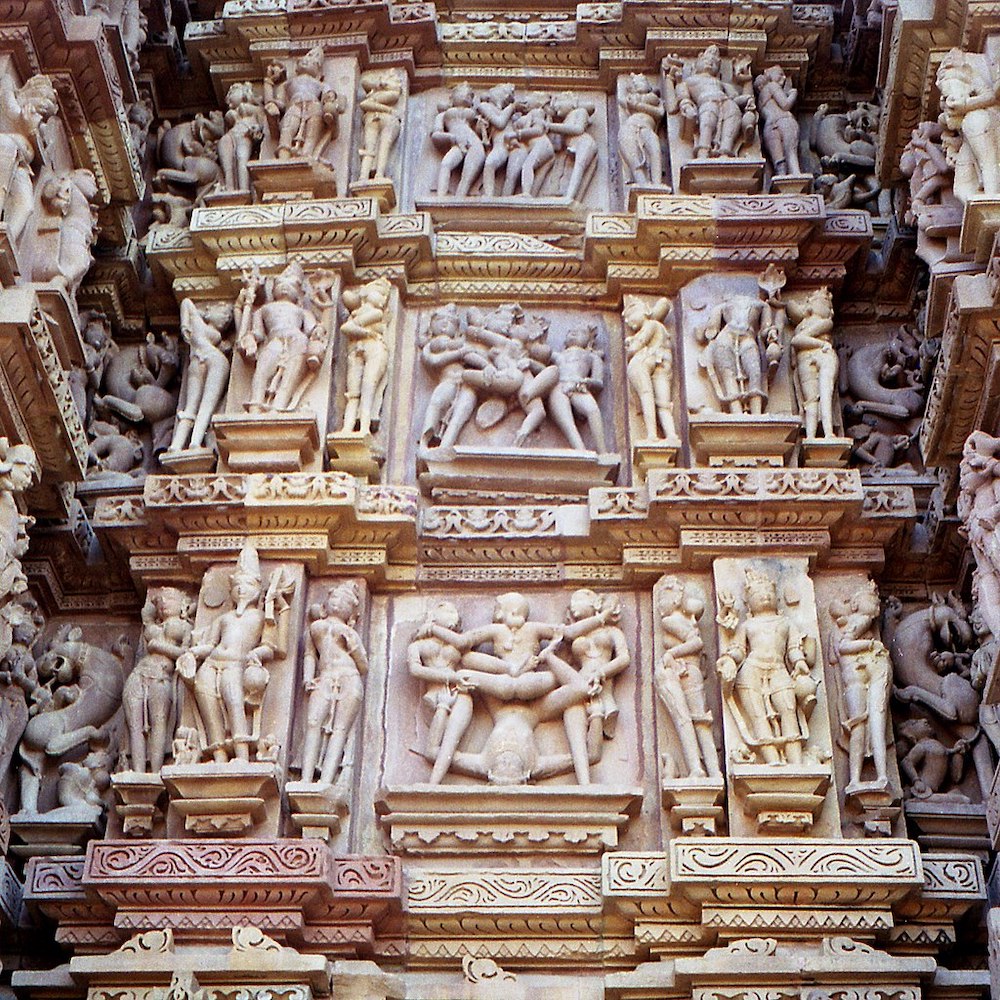
Ancient India didn’t just give us the Kama Sutra, those famous pages of positions and possibilities for ecstasy. The Hindus built monumental temples that included thousands upon thousands of three dimensional carvings, erotic sculptures that celebrated every conceivable communion.
When the Islamic invaders entered India, they destroyed the great Hindu temples, along with the actual Hindus. Islamic historians like Muhammad Qasim Hindu Shah, writing from the victor’s perspective in the 1500s, took credit for some 400 million deaths, while more conservative calculations of carnage suggested a mere 80 million massacred. In any event, by the 1300s, there was no sign left of countless creations by the Hindu people, let alone the carnal carvings. The offending sculptures had been destroyed or exiled into natural absorption by the habitat.
The ruins of a few temples near Khajuraho were rediscovered by the next colonizers, the British, in the 1830s, a stroke of good fortune for the preservation of the world’s anthropologies. Although only 10% of the artwork of these temples is erotic, that is of course the most famous percent. The figures cavort with acrobatic ability that will defy most of us, making good use of all that yoga and every available orifice of man, woman, or beast. Kids, don’t try this at home!
India’s wine history is as rich and brutal as the story of the Khajuraho temples. Ancient Vedas celebrate wine, but it was probably made from currents and from rice. The elite and privileged had the good stuff: grain based booze was more typical for lower castes, and so millet and barley beer was common. Later, alcohol was against Islamic law. The Portuguese introduced wine again in the 1500s, and the British wanted more of it and planted extensive vineyards in the 1800s. But then came along an epidemic of phylloxera, which devastated the whole shebang. It wasn’t until the 1980s that efforts were rekindled and India’s modern wine industry was born. It is tiny, and the only Indian wine I could find available here in Toronto was Soul Tree Shiraz. And it wasn’t bad, if you enjoy twisty turny wines that hint at coffee and green peppers. To be fair, pairing a wine with this art demands a beverage that is both religious and sexually acrobatic. It’s a tall order – if you find it, let me know!
Three Lovers, Theodore Gericault, 1819
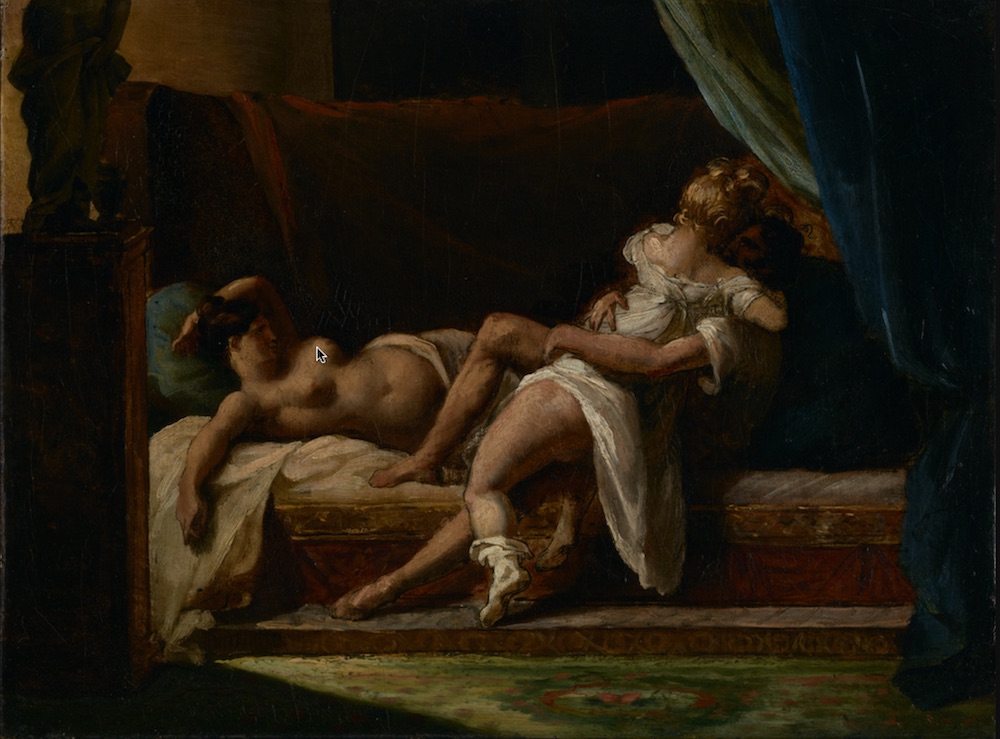
Ladies and gentleman, here you have it, an erotic painting of true rarity. A single nude or a multitude were both common, but three in a sexual embrace is difficult to find before contemporary times. This piece is not only a stunning work by one of the great artists of all time, it is his only known erotic work.
It is also striking because he created it at the same time or just after the work, The Raft of the Medusa, one of the most important paintings in history. The Raft was some 16 by 23 feet large, with life-size figures illustrating a historical catastrophe. This piece is tiny, 9 x 12 inches. It was clearly created for the private pleasures of a patron. Why Gericault indulged the request while he was immersed in the epic work, we cannot know. It was perhaps for a friend, although the piece was retrieved from the artist’s studio at his death, so it was never given.
It may be that Teddy created the work for his own private use, perhaps illustrating his own fantasy, but this is pure conjecture. Perhaps Gericault created many small sensual paintings for private patronage, and we are simply not yet aware of them. This is my hope, because it means splendid surprises may await lovers and art lovers alike.
There’s only one wine to pair with Three Lovers, and it is Three of Hearts Rose. It is a pale petal of a rose, exquisitely light and dry, but still bursting with citrusy pomelo fruit and candy hearts.
Happy Valentine’s Day!
Visit artist Lorette C. Luzajic’s website mixedupmedia.ca, and see all of her GFR Wine and Art series here.

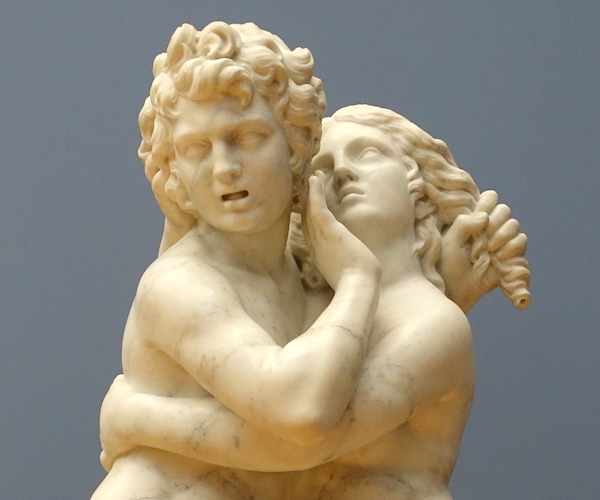






wow that was brilliant
Thank you Scott!
Indeed!